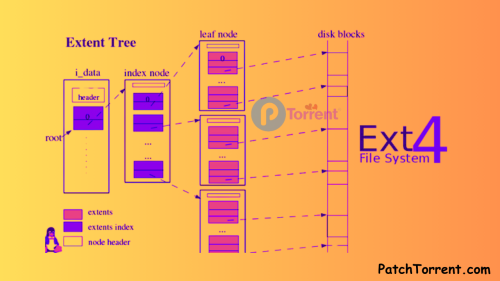Linux File Systems for Windows
Linux File Systems for Windows is a specialized utility that grants complete access to the Ext2/Ext3/Ext4 file systems from within the Windows environment. The Linux File Systems for Windows add-on makes it easy to work with Linux-based file systems from within Windows. When you plug in a hard drive with ExtFS partitions to your personal computer, you’ll have instant access to all the files saved on the Linux partitions. And it’s compatible with LVM (Logical Volume Management) read/write operations as well.

Linux File Systems for Windows Torrent is a Windows program that assists users in accessing data stored on Ext2/Ext3/Ext4 partitions. From ExtFS partitions, users may easily import and export documents and other file kinds. Additionally, users can access multimedia files directly without copying them using this software. Paragon Software’s Linux File Systems for PC is a top-notch service that gives you full access to Linux volumes from inside Windows.
An invaluable tool for managing files on a hard drive that has been retrieved from a Linux-based NAS storage. A user can quickly access their files by connecting the disk to their computer with an eSATA connector or a USB-to-SATA adaptor. The tool’s user-friendliness lies in the fact that its main features are conveniently located in a top toolbar. When users connect the drive to a Windows PC, Linux File Systems for Windows ensures that huge movies stored on Ext2/Ext3/Ext4 partitions can be accessed immediately, without the need to transfer them to a new hard disk.
What Is Ext4 File System Linux?

Drawing inspiration from Minix, the Extended File System (ext) was developed in 1992 with the express purpose of being used by the Linux operating system. Following its release as an update in 1993, Extended File System 2 (ext2) became the de facto standard for many Linux versions for several years. As ext3 was developed in 2001, journaling was added to ext2 to protect data from corruption in the event of failures or power outages. Released in 2008, Ext4 (Fourth Extended Filesystem) eventually replaced all previous Linux filesystems in 2010. The drawbacks of its predecessor, ext3, were addressed in Ext4, which was designed as an incremental update.
How Does Copy-on-Write Work and Why Would You Want It?
Modifying a file in a conventional file system entails reading the data, making edits, and then writing the modified version back to the original location. In contrast, a copy-on-write file system reads the data, makes changes, and then writes the modified version to a new location. Because the data stays on the disk during the read-modify-write operation, this method avoids data loss. If the power goes out or the computer crashes, the file system won’t create corrupted or partially written blocks since it waits until the new block is completely written out before repointing.
Hence, filesystem checks are unnecessary during startup, which lowers the probability of data damage. In addition, you can take a snapshot of the filesystem at any time using copy-on-write file systems, saving the metadata points as they are right now. These snapshots prevent the deletion of old blocks and allow the filesystem to display a volume exactly as it was when the snapshot was taken. In essence, this allows for immediate rollback capabilities, and, using the snapshot as a basis, you can even clone a disk to make it writable.
Also Available: Corel Draw X7 Download
Features of RS Linux Recovery:
- Getting data back after deleting or reformatting logical partitions
- Repairing partitions that have been destroyed due to power outages, hardware problems, system crashes, or any other issue
- Extraction of lost data from a wide variety of hard disk drives and portable storage devices
- Recovering information from virtual machine disk images and files (.dsk,.hdd,.vdi,.vhd,.vhdx,.vmdk)
- Recovery of corrupted partitions and reconstruction of severely damaged logical disk structures
- The use of virtual disk images for delayed data recovery
- Getting back lost files from a variety of sources, including Adobe Reader documents, databases, digital images, photographs (in any format), and audio and video files
- File formats supported by ReiserFS, XFS, UFS, exFAT, FAT, ReFS, and Ext2/3/4
System Requirements
| Operating Systems | Windows 10, Windows 8.1, Windows 7 |
| Data Storage | 2 GB of RAM is required, with 4 GB being ideal |
| Available Hard Disk Space | 200 MB |
How To Download & Install?
- Begin downloading by clicking on the appropriate button(s) below.
- The time required could range from minutes to hours, depending on your internet connection.
- Download the files and then extract them. Read this post if you need help extracting files.
- To install the software, run the Setup.msi file.
- Take the “Linux File Systems for Windows by Paragon Software.exe” and “paragon_service.exe” files out of the
- Make the folder and replace them with the ones already there in your installation directory.
- Good job! Paragon Linux File Systems for Windows, the complete version, has been installed on your PC.
Conclusion
In Conclusion, Choosing the right file system for your specific application needs involves careful consideration and research of various factors. This article provides an overview of the benefits offered by ext4, ZFS, XFS, Btrfs, and Reiser4 file systems, aiming to help you make an informed decision when selecting the appropriate file system for your application environments.

![Linux File System 6.1.5 & Directory Structure Download [2024] Linux File Systems Free Download](https://patchtorrent.com/wp-content/uploads/2024/03/Untitled-design-5-1.png)